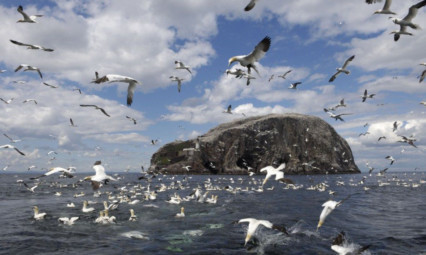
A wonderful flight of fancy.
Scotland has stunning scenery and whisky, warm welcomes and history by the bucketload.
But we’ve also got somewhat surprisingly I’ve got to admit birds.
Not just some feathered friends looking hopefully for scraps in the back garden, but genuinely globally important flocks of the little things.
And North Berwick’s the place to see them.
Our base, Gilsland Park, could hardly be better positioned to get a perfect panorama.
Owner Carlene tells us it’s been a restful haunt for four generations now. Her
great-grandad, a GP, initially used it to aid his patients’ recuperation.
Her grandad turned it into more of a business and, following on from her uncle, Carlene and her brother run what’s a very smart operation.
There’s a mix of permanent caravans, quirky one-room huts think the cutest Wendy house and three-bedroom lodges.
We were in one of those, Gannet, and what a treat!
White, wooden-floored, well-equipped kitchen, but best of all was the extensive decking area with its own hot tub.
You might think that an outdoor hot tub and Scotland don’t mix.
But, as we discovered, they do!
It’s a leisurely 20-minute stroll into the town and the first stop on our East Lothian exploration is the Scottish Seabird Centre.
Right at the harbour, it’s a terrific place to while away an afternoon.
The Discovery Centre has live cameras you can control, zooming in on the amazing colonies of birds.
There are cameras on Craigleith, Isle of May, Fidra, Bass Rock and Dunbar harbour.
For the next few weeks you can see the puffins on Craigleith. It’s home to some 8,000 impressive, but 20,000 fewer than there were at the turn of the millennium thanks to an invasive plant called tree mallow which volunteers spend the winter trying to cut back.
But while the cameras give you fantastic close-up shots allowing you to feel like a wildlife cameraman, the best way to see them is up close and in the flesh.
So we hop on one of the hour-long catamaran trips, first to Craigleith, then on to the Bass Rock.
Nothing quite prepares you for this amazing spectacle. There are 150,000 northern gannets, the largest colony in the world.
The helpful guide points out how they indicate they are about to take off by pointing their beaks to the sky and show affection for their mates by entwining their beaks together.
It’s a nature documentary, in real life and 3D, just yards away. And it’s obviously inspiring right across the generations with everyone from older couples to young kids seeming remarkably informed.
Back on dry land and just along the coast is mighty Tantallon Castle, dating back to the 1300s.
Built by William, Earl of Douglas and added to over the centuries, its rich history is plain to see. With some walls up to
13ft thick it’s easy to see how it has stood the test of time, and it’s now well looked after by Historic Scotland.
A good way to really appreciate both its history and its solidity is to hit the heights and plumb the depths.
Take one of the two stairways up to the battlements where you can learn about the 16th Century siege while drinking in the superb views far into the distance.
Then head back down to have a peer down the 100ft deep well.
And then follow the steps right down into the lowly, dark and cramped prison where the only luxury afforded to the prisoner was the icy latrine.
At the nearby National Museum of Flight at East Linton work is under way on transforming two old hangars into huge new display spaces enabling aircraft to be shown off as never before.
But, for the moment, there’s no doubting that Concorde is still the star of the show.
You can trace its story from the earliest breaking of the sound barrier to the tragic Paris air crash in 2000.
Standing right under the plane it’s hard not to visualise the swift and deadly horror.
Head up the steps, though, and you see how the other half flew.
It’s actually not quite as narrow and tight as I imagined but flying at 60,000 feet and 1,350mph it must have been an experience like no other.
There’s plenty more to do in this vast sprawling site including the military aviation hangar housing the deadly Tornado and the legendary Spitfire.
Well worth a few hours of anyone’s time and loads to keep kids entertained.

Enjoy the convenience of having The Sunday Post delivered as a digital ePaper straight to your smartphone, tablet or computer.
Subscribe for only £5.49 a month and enjoy all the benefits of the printed paper as a digital replica.
Subscribe